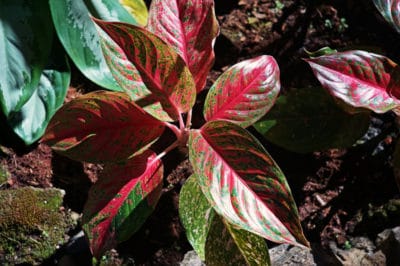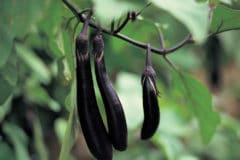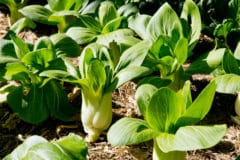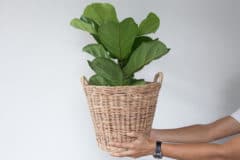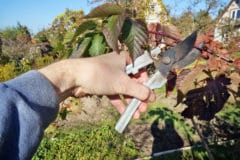Where Should I Plant Chinese Evergreens Outdoors?
As you might expect from their place of origin, Chinese evergreens require warmth, moisture, and filtered sunlight or shade. The preference for subdued light is one of the traits that make Chinese evergreens so easy to grow successfully as houseplants.
Newer varieties with shades of pink, red, or orange in their leaves actually require moderate light too maintain their coloring.
If you live in USDA hardiness zones 10B through 11, you can use Chinese evergreens outdoors in your landscaping. Look for a shaded area of sandy or loamy soil that retains a moderate level of moisture without becoming muddy. Enrich the soil with humus.
If you want to grow these plants outdoors in other areas, try growing them in pots and containers that can be moved inside when temperatures cool.
How Do I Grow Chinese Evergreens in Containers?
Chinese evergreens range in height to from 10 inches to 3 to 4 feet tall and from 2 to 4 feet in circumference. However, smaller pots help to prevent the soil from becoming too moist, so choose pots from 2 inches to 14 inches across if you are putting your Chinese evergreens in separate pots.
Possibly as a result of their tropical forest origins, Chinese evergreens don’t mind becoming a bit root bound.
You can also plant several Chinese evergreens together in a larger container or plant them as undergrowth with a taller plant or potted tree. Allow 2 to 3 feet between plants when placing two or more in the same container or when planting them outdoors.
Use a potting soil for flowering plants mixed with sand or perlite for best results.
Because Chinese evergreens grow slowly, you’ll only need to repot them every two to three years.
What Temperatures Are Best for Growing Chinese Evergreens?
While varieties have been developed that can withstand cooler temperatures, you should not expose your Chinese evergreens to drafts or temperatures lower than 50°F to 55°F (10°C to 13°C). It’s best to maintain an average temperature between 70°F and 72°F (21°C to 22°C) and not allow the temperature to drop below 60°F (16°C) to be certain to avoid damage to the plant’s leaves.
Damaged leaves develop dark or brown greasy looking patches.
How Do I Propagate Chinese Evergreens?
Allowing the flowers to appear and develop seeds shifts the focus of the plant’s energy away from producing leaves. However, you can harvest the seeds and try growing new plants from them.
Outdoors, stems that touch the ground may produce roots and give rise to new plants.
Chinese evergreens are most commonly propagated from cuttings taken from the plant or by dividing the clusters of plant roots when repotting
How Do I Propagate Chinese Evergreens From Cuttings
To propagate Chinese Evergreens from cuttings:
- Make your cuttings from healthy plants in the late spring or early summer.
- Cuttings should be 4 inches to 6 inches long.
- Use floral snips or scissors or pinch the stem with your fingernails just below a pair of mature leaves.
- Remove the leaves from the bottom half of the cutting and place the stem in an 8-ounce container of water.
- Place your cuttings on the windowsill of a window that receives moderately bright filtered sunlight.
- Replace the water in the container as it evaporates.
- Roots should appear in about two weeks. After the roots appear, allow them to grow to at least 1/2 inch long. The roots will be delicate, so handle them carefully during transplanting.
- With the cutting still in the container of water, mix four parts floral potting soil with one part perlite, and fill the bottom third of a 4 inch container with this potting mixture.
- Lift the cutting from the container of water and rest it’s base against the top of the potting mix while holding the cutting upright in the container with one hand.
- Use your other hand to add potting mix to the container until the bottom half of the cutting is covered.
- Tamp the soil lightly around the cutting to hold it upright, but avoid crushing the roots.
- Slowly pour 1/8th cup of water around the cutting and then cover it with a large, clear plastic bag to reduce evaporation and improve humidity.
- Leave the bag in place for two to three weeks before removing it.
- Let your Chinese evergreen grow for another two weeks and then test it’s root development by gently tugging on the base of the plant to see how firmly it is anchored in the potting mix.
- In two to three months, you can transfer your Chinese evergreens to their permanent pots or permanent place in your landscaping.
How Do I Propagate Chinese Evergreens by Dividing the Roots?
When you repot your Chinese evergreens, you will see that the roots grow in clusters of basal shoots. Carefully separate these shoots with your fingers or carefully cut them apart if necessary. Keep three to four leaves with each shoot. It’s best if each shoot also has roots attached, but Chinese evergreens form roots readily on their own if you should have shoots with no roots.
Place each shoot in a separate pot with fresh potting mix. Water the repotted plants well, but do not allow the potting mix to remain muddy. Also, don’t allow water to stand in the pots.
How Do I Care for My Chinese Evergreens?
Chinese evergreens do not tolerate dry air any better than they tolerate drafts and cool temperatures. They will do best in rooms where humidity is naturally high, like bathrooms and kitchens.
You can keep your plants in these rooms most of the time but bring them out when you are entertaining and want them to decorate your home.
Just remember to keep them away from areas where they might be in a draft from doors as guests come and go. Also avoid placing them in areas where temperatures might change suddenly such as near refrigerator doors or eating an cooling vents.
If you want to keep your Chinese evergreens in other rooms, using a mister on the leaves helps increase humidity but it’s not sufficient on it’s own.
You can increase humidity in other rooms by keeping a humidifier nearby or by placing marbles or pebble in a tray, filling the tray with water, and them sitting your potted plants on the marbles or pebbles. The water increases the humidity around the plants as it evaporates.
During the spring and summer, water your Chinese evergreens often enough to keep the soil moderately moist, but allow the top two inches of potting mix to dry out between each watering. The less light your plants receive, the more you should let the soil dry out between waterings. You should reduce watering during the fall and winter.
Chinese evergreens are sensitive to chlorine in water, so if you use tap water to water your plants, let the water sit in an open container for a few minutes before watering your plants with it. That will allow the chlorine to evaporate.
Again during the spring and summer growing season, you should feed your Chinese evergreens with balanced 20-20-20 liquid fertilizer every two to three weeks. Feed your plants less frequently during the fall and winter.
Periodically remove dust from the leaves by wiping them with a soft, damp rag. You can also place them under the shower, but be sure that the potting mix doesn’t become too wet and that the leaves dry thoroughly.
What Pests and Diseases Can Affect Chinese Evergreens?
Like Calathea, Chinese evergreens are susceptible to spider mites, aphids, mealy bugs, as well as scale insects, and fungal problems like stem and root rot. Chinese evergreens show many of the same symptoms as Calathea, and the same remedies can be applied
Are There Any Precautions I Should Take When Growing Chinese Evergreens?
Chinese evergreens contain calcium oxalate crystals. The sap can irritate the skin and even cause a painful rash. If eaten by children or pets, the crystals can irritate the mucous membranes of the mouth and throat. For that reason, these plants are considered toxic.
However, even though the stems of Chinese evergreens root readily if they come in contact with the ground, they grow so slowly that they are not considered an invasive species anywhere in the world.
